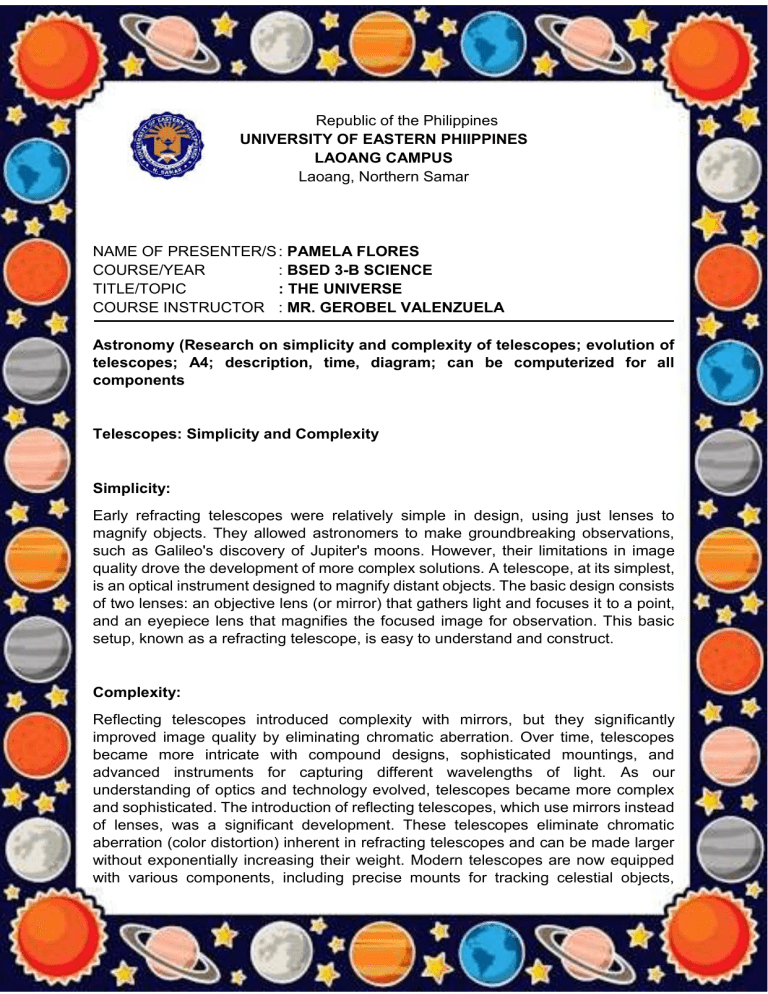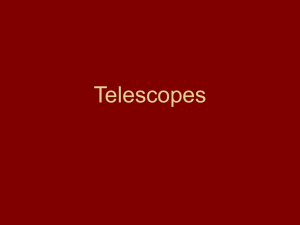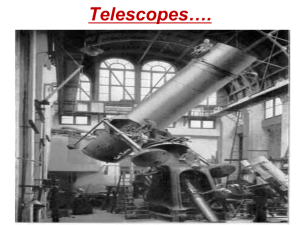
Republic of the Philippines UNIVERSITY OF EASTERN PHIIPPINES LAOANG CAMPUS Laoang, Northern Samar NAME OF PRESENTER/S : PAMELA FLORES COURSE/YEAR : BSED 3-B SCIENCE TITLE/TOPIC : THE UNIVERSE COURSE INSTRUCTOR : MR. GEROBEL VALENZUELA Astronomy (Research on simplicity and complexity of telescopes; evolution of telescopes; A4; description, time, diagram; can be computerized for all components Telescopes: Simplicity and Complexity Simplicity: Early refracting telescopes were relatively simple in design, using just lenses to magnify objects. They allowed astronomers to make groundbreaking observations, such as Galileo's discovery of Jupiter's moons. However, their limitations in image quality drove the development of more complex solutions. A telescope, at its simplest, is an optical instrument designed to magnify distant objects. The basic design consists of two lenses: an objective lens (or mirror) that gathers light and focuses it to a point, and an eyepiece lens that magnifies the focused image for observation. This basic setup, known as a refracting telescope, is easy to understand and construct. Complexity: Reflecting telescopes introduced complexity with mirrors, but they significantly improved image quality by eliminating chromatic aberration. Over time, telescopes became more intricate with compound designs, sophisticated mountings, and advanced instruments for capturing different wavelengths of light. As our understanding of optics and technology evolved, telescopes became more complex and sophisticated. The introduction of reflecting telescopes, which use mirrors instead of lenses, was a significant development. These telescopes eliminate chromatic aberration (color distortion) inherent in refracting telescopes and can be made larger without exponentially increasing their weight. Modern telescopes are now equipped with various components, including precise mounts for tracking celestial objects, computerized systems for automated pointing and imaging, and advanced detectors for capturing light. Modern Advances: Space telescopes exemplify complexity by requiring precise engineering for launch, deployment, and communication. Adaptive optics add complexity to ground-based telescopes, incorporating real-time computer-controlled adjustments to counter atmospheric effects. Evolution of Telescopes: Refracting Telescopes: The first telescopes, developed in the early 17th century, were refracting telescopes. They used lenses to bend and focus light, magnifying distant objects. However, these telescopes suffered from chromatic aberration - different colors of light focusing at different points, leading to image distortion. Reflecting Telescopes: To overcome the limitations of refracting telescopes, Isaac Newton introduced the reflecting telescope in the mid-17th century. These telescopes use mirrors to reflect and focus light, avoiding chromatic aberration and allowing for larger aperture designs. Compound Telescopes: Compound telescopes, also known as catadioptric telescopes, combine lenses and mirrors to achieve a balance between compact design and image quality. Examples include Schmidt-Cassegrain and Maksutov-Cassegrain telescopes. Radio Telescopes: In the 20th century, astronomers expanded their observations beyond visible light by developing radio telescopes. These telescopes detect radio waves emitted by celestial objects, providing insights into the universe's radio emissions, including distant galaxies and cosmic background radiation. Space Telescopes: Placing telescopes in space eliminates the distortion caused by Earth's atmosphere. The Hubble Space Telescope is a prime example, capturing stunning images of distant galaxies, nebulae, and other cosmic phenomena. Adaptive Optics: To counter the blurring effects of Earth's atmosphere on ground-based telescopes, adaptive optics technology was developed. It involves real-time adjustments of the telescope's mirrors to compensate for atmospheric distortions. Evolution of Telescopes: 1. Galilean Telescope (1609): Diagram: Galilean Telescope Diagram Description: The Galilean telescope, invented by Galileo Galilei, consisted of a convex objective lens and a concave eyepiece lens. It produced an upright, magnified image. Explanation: Light entered through the objective lens, forming an inverted real image. The eyepiece lens magnified this image for observation. Keplerian Telescope (1611): Diagram: Keplerian Telescope Diagram Description: Johannes Kepler improved the design with a convex objective and convex eyepiece lens. This produced an inverted image that allowed for higher magnification. Explanation: The objective lens formed an inverted real image, and the eyepiece lens magnified it. This design reduced aberrations. Newtonian Reflecting Telescope (1668): Diagram: Newtonian Telescope Diagram Description: Isaac Newton introduced the reflecting telescope, using a curved mirror as the objective instead of a lens. A flat diagonal mirror reflected the image to an eyepiece on the side of the telescope. Explanation: Light collected by the mirror was reflected to the side of the telescope, allowing for easier observation. Hubble Space Telescope (1990): Diagram: Hubble Space Telescope Description: The Hubble Space Telescope is a space-based observatory with a 2.4-meter primary mirror. It orbits Earth and captures images using various instruments across the electromagnetic spectrum. Explanation: Hubble's position above Earth's atmosphere eliminates distortion and allows for stunning images of distant celestial objects. James Webb Space Telescope (Upcoming): Diagram: JWST Diagram Description: The James Webb Space Telescope (JWST) is a highly anticipated successor to Hubble. It's optimized for infrared observations and has a large segmented mirror. Explanation: JWST's advanced technology will enable us to study the universe in unprecedented detail, revealing information about distant galaxies, stars, and planetary systems. 1608: Lippershey's Refracting Telescope Description: In 1608, Dutch spectacle maker Hans Lippershey created one of the earliest known refracting telescopes. It consisted of a convex objective lens and a concave eyepiece lens, enclosed within a tube. When pointed at distant objects, it produced magnified images, thus allowing for significant advancements in astronomical observation. Explanation: Lippershey's telescope marked a pivotal moment by introducing a practical instrument that could magnify distant objects, leading to groundbreaking astronomical discoveries by Galileo Galilei and Johannes Kepler. Time: Early 17th century (1608) 1672: Cassegrain Telescope Concept Description: The Cassegrain telescope, conceived by French priest Laurent Cassegrain in 1672, is a type of reflecting telescope. It involves light entering the telescope through an aperture and reflecting off a primary mirror onto a secondary mirror, which then directs the light to an eyepiece or detector. Explanation: Cassegrain's concept expanded the possibilities of telescope design, enabling longer focal lengths in a more compact instrument, which was especially beneficial for astronomical observatories with limited space. Time: Late 17th century (1672) 1780s: Achromatic Lenses Introduced Description: Achromatic lenses are lens systems that consist of two or more lenses made of different types of glass. They were introduced in the 18th century to address chromatic aberration, a problem that caused colored fringes around objects when using simple lenses. Explanation: Achromatic lenses combined different glass types to minimize chromatic aberration by refracting different colors of light by varying amounts. This advancement greatly improved the quality of images produced by refracting telescopes. Time: 1780s 1845: Large Refractor at Pulkovo Observatory Description: The Great Refractor at the Pulkovo Observatory in Russia, completed in 1845, was a massive refracting telescope with a 15-inch (38 cm) diameter lens. It was one of the largest refracting telescopes of its time and played a significant role in advancing observational astronomy. Explanation: Large refracting telescopes like the one at Pulkovo Observatory allowed astronomers to observe celestial objects with greater detail and clarity. Its impressive size and precision optics contributed to groundbreaking discoveries Time: 1845 1923: Schmidt-Cassegrain Telescope Description: The Schmidt-Cassegrain telescope, developed by Bernhard Schmidt in 1931 but popularized in the 20th century, combines elements of both the Cassegrain and Schmidt camera designs. It features a corrector plate at the front to eliminate spherical aberration and coma, resulting in a compact yet high-performance instrument. Explanation: The Schmidt-Cassegrain design revolutionized amateur astronomy by providing a compact and versatile instrument capable of capturing deep-sky images. Its popularity surged due to its ease of use and portability. Time: 1923





